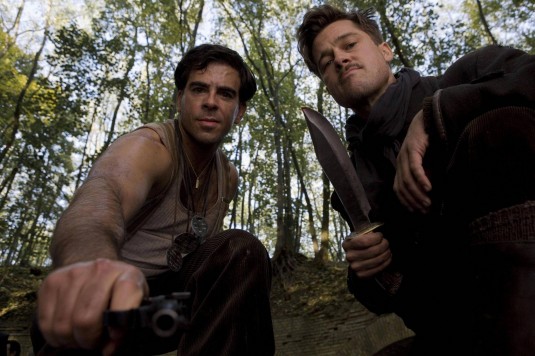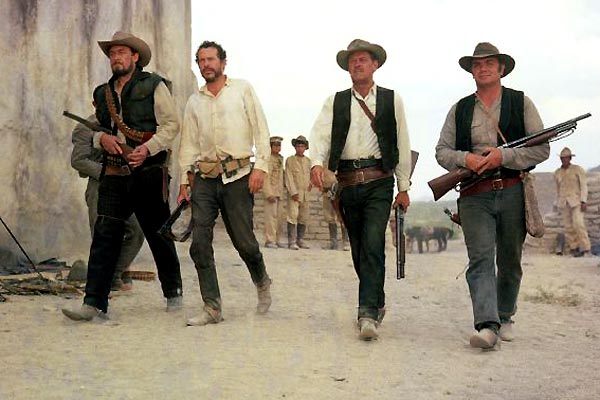Spoiler alert-o-meter: Multiple spoiler alerts ahead
Watching onscreen violence can be a release, a harmless thrill; we watch murder most vile so we won’t actually perform the acts ourselves. Today, PG-13 movies show blood-soaked bullet holes and hungry vampires/zombies in action. And America loves it.
Quentin Tarantino’s Inglourious Basterds, which includes scenes of intense violence, was on many critics’ 2009 top ten lists. Reviews skewed mostly to the B, B+, A- range. It was nominated for best picture back in February, but lost out to the Hurt Locker. While it’s not the best movie of last year, it was one of the most entertaining ones. And was not just critics who thought so: the movie became Tarantino’s biggest box office hit.
Most of Tarantino’s movies exploit violence, and especially violent revenge, for entertainment. But years before Tarantino watched his first exploitation flick, director Sam Peckinpah released a string of visceral action movies, starting with The Wild Bunch in 1968, which helped usher in a new generation of movies that didn’t have to shy away from realistic gunplay. In The Wild Bunch, and later with The Getaway and Straw Dogs, Peckinpah staged action scenes as an extended slo-mo catharsis of revenge-fueled violence.
His movies don’t just build to a violent ending; they start violently and continue relentlessly until the bloody finale. Peckinpah’s anti-heroes live by an ethical code of conduct that ultimately places them in deadly confrontations whose outcomes are certain death. But the protagonists continue in the face of incredible odds because they know they are doing the right thing within the construct of their world view. For Peckinpah, codes are often forged from money, friendship, and revenge, forking into sub-code tributaries like honor, pride, and shared history.
His scenes of violence cultivate a universal feeling of us-against-them. The aging gang at the heart of The Wild Bunch is screwed by a Mexican general when he kills a member of the Bunch after promising to let him go. In turn, they kill the general in his compound and go down in a blaze of guts and glory. The Bunch knew their way of operating was displaced in the new west and would probably get them killed. Why not go on their terms?
Peckinpah was always attracted to outsiders and what happens when they’re double-crossed. As David Thompson says in The New Biographical Dictionary of Film, “Throughout Peckinpah’s work, there is the theme of violently talented men hired for a job that is loaded with compromise, corruption, and double-cross. They strive to perform with honor, before recognizing the inevitable logic of self-destruction.”
The Getaway starts with Steve McQueen as Doc McCoy leading a dangerous a bank heist. When he’s double-crossed, the movie blooms into a drawn-out chase, ending with a brutal, inevitable shootout in the hallways, stairwells, and elevators of a Mexican border town hotel. We know what’s coming, the movie telegraphs it an hour beforehand. But this foreshadowing ramps up the conflict and tension leading to McCoy’s final retribution.
Peckinpah is a master at building tension. Even after a dozen viewings I still get a jolt when I pop in The Wild Bunch. The title sequence alone is textbook Peckinpah: cross-cutting between the interior and exterior of a bank during a daring robbery. It's like putting the climax of a film at the beginning, and pulling us along through the rest until the bloody end.
Straw Dogs breaks Peckinpah's own mold, showcasing the slow boil of violence within an average man. Dustin Hoffman plays a laid back mathematician, recently moved, with his beautiful blond wife played by Susan George, to George's hometown in the UK countryside. The movie builds by highlighting a series of increasingly intense conflicts that play out between Hoffman, George, and a band of insular and increasingly dangerous locals.
During the last half hour of the film, the band lays siege to the couple's house. Mild mannered Hoffman, until then avoiding confrontation, protects his wife, his house, and ultimately his life with acts of barbarity and cunning that make the previous 90 minutes look like a vintage PBS special about life in rural Britain. We are all capable of revenge violence, Peckinpah seems to be saying.
During the last half hour of the film, the band lays siege to the couple's house. Mild mannered Hoffman, until then avoiding confrontation, protects his wife, his house, and ultimately his life with acts of barbarity and cunning that make the previous 90 minutes look like a vintage PBS special about life in rural Britain. We are all capable of revenge violence, Peckinpah seems to be saying.
Pupil Tarantino tweaks Peckinpah’s vision of revenge ethics so that dilemmas are never black and white. Tarantino’s rogue characters operate in a contemporized moral gray area. In his first movie, Reservoir Dogs, (notice his tip of the hat to his elder by using Dogs in the title) a band of robbers is hired by a third party to pull a heist.
After the robbery, the band meets in an abandoned L.A. warehouse where each character introduces personal codes that fuel his behavior. For example, Michael Madson’s Mr. Blonde likes to torture cops and Harvey Keitel’s Mr. White is an old-school criminal in it for the money. Mr. White also has a gooey moral center that does him in by the end when he discovers the robber he’s been protecting turns out to be an undercover cop.
In Pulp Fiction's moral universe, Butch the fighter (Bruce Willis), through a series of random events, helps his nemesis, Marsellus Wallace (Ving Rhames), out of a tight spot. Butch and Marsellus are tied together by double-cross and revenge: Butch was paid to throw a fight, which he did not. Marsellus lost big money on the fight and wants Butch gone. Saving Marsellus’ from the clutches of a couple of L.A. racists will more than square Butch. Butch is generally honorable, so watching him liberate Marsellus is entertaining and satisfying.
In Kill Bill 1 and 2, Tarantino serves revenge as the main course, and turns in over three hours of Uma Thurman's wronged Bride as an ass-kicking samurai warrioress bent on completing the titular task. It’s almost a let down when Bill is finally killed with a low-key martial arts blow—tame compared to the mayhem that precedes it.
With Inglourious Basterds, Tarantino revises WWII for a new generation, this time as a revenge-fueled fantasy pitting American and French Jews against Nazis in German-occupied France. Audiences gave two thumbs up to the movie’s hard R-rated violence, perhaps suggesting Americans are collectively tired of fighting unwinnable wars and amorphous foes. Maybe we want to relive America’s last genuine win.
The opening scene of Inglourious Basterds extends for about 20 minutes. Presented in real-time, the scene sets up many things: we’re in Nazi-occupied France and are in the company of feared Nazi Colonel Hans Landa, nicknamed the Jew Hunter. During an extended dialogue scene in a farmhouse where he sweats a farmer for information, Landa determines that the cellar below them is the hiding place of a Jewish family. When German soldiers kill the family, a girl escapes.
This sets up what must be the most outrageous revenge fantasy ever filmed. Tarantino revises history to suit his purposes of conflict, tension, and revenge. Seeing a theater-full of Nazis, including Hitler, Goering, and Goebbels, die at the end of the movie was a little bit of heaven on a rainy September afternoon. For decades the Holocaust has been the subject of movies that were sometimes of questionable taste. Finally a filmmaker cuts to the chase and shows us what audiences have wanted all along.
Where does violence in movies go from here? What else is there for these aging outsider anti-heroes and their directors to do? Peckinpah, for his part, tackled oncoming old age by asking the macho old-man question: how do you grow old without getting done in by modern ways? The essence of Peckinpah’s aging moral outrage can be reduced to a moment, a sentence, when during The Wild Bunch’s opening bank robbery William Holden shouts to one of his Bunch: “If they move, kill ‘em.”
Tarantino, now in his mid-to-late 40s, shows no sign of changing gears. As he said in the August 2009 GQ, he has already made his character-driven, mature work about getting old, Jackie Brown. “And it’s as much of an old-man movie as I ever want to make.” Tarantino will eventually pass the torch to another generation of revenge-violence filmmakers, but it sounds like he’s not going quietly out without a cinematic fight.
The Wild Bunch trailer:
Need more? To see an 30-second distillation of Reservoir Dogs performed by animated bunnies, click here.








2 comments:
Many people do love to watch violent films. I'm not one of them.
Although these filmmakers are brilliant and I have seen a couple of the movies you mentioned, I will skip a movie if I hear or read of too much violence.
Violence is more upsetting to watch as I get older. The stuff that maybe thrilled me now is just too visceral. Too much. But, it can still be presented well to get a point across. But there's no way I would watch Saw 4 or something like that.
Post a Comment